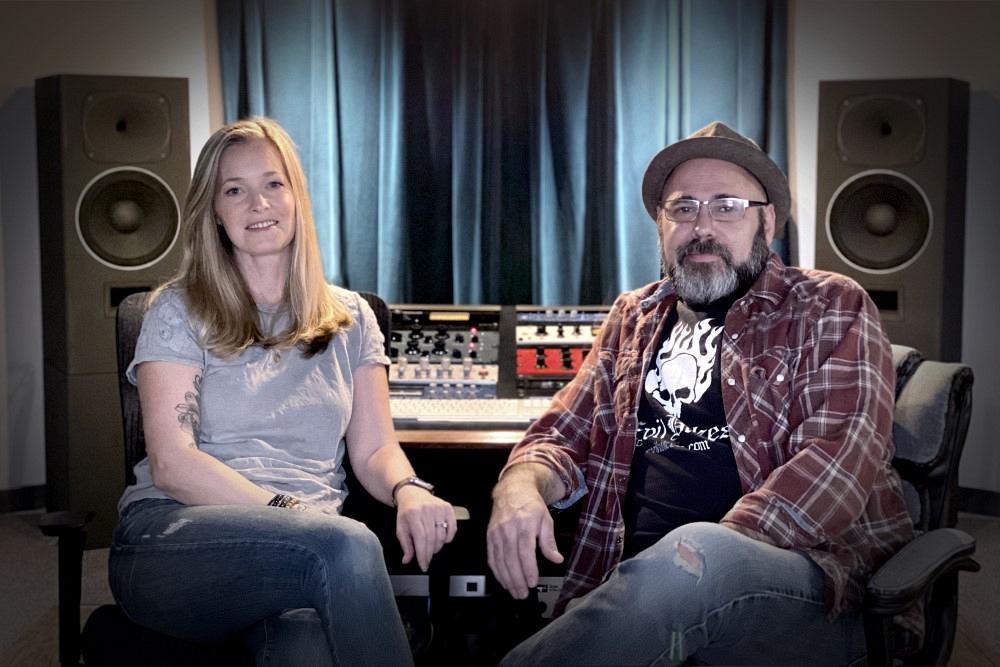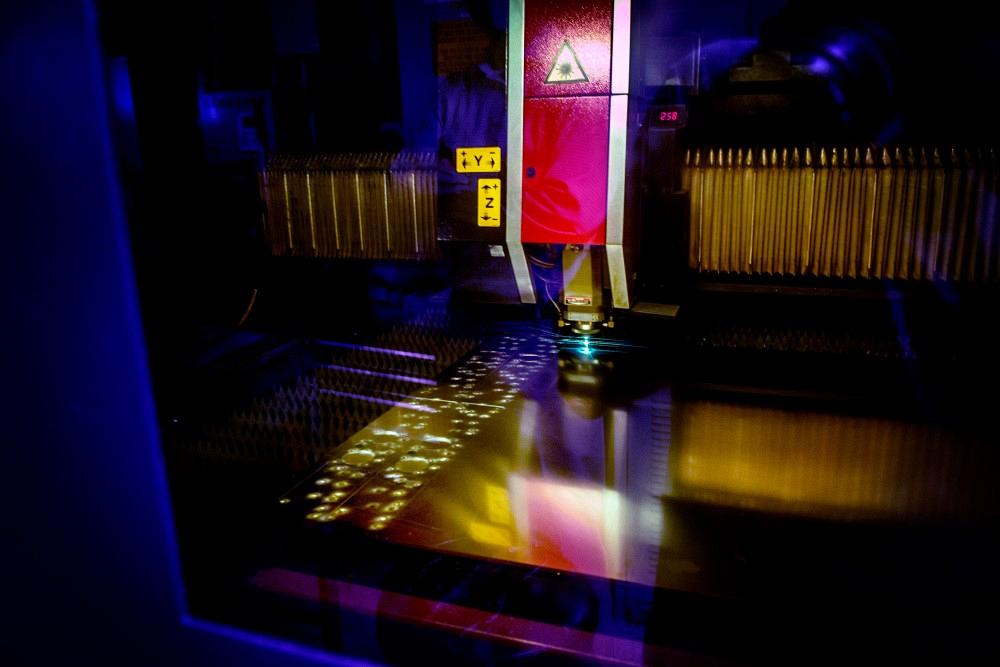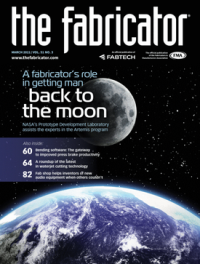Marketing and Communications Manager
- FMA
- The Fabricator
- FABTECH
- Canadian Metalworking
Categories
- Additive Manufacturing
- Aluminum Welding
- Arc Welding
- Assembly and Joining
- Automation and Robotics
- Bending and Forming
- Consumables
- Cutting and Weld Prep
- Electric Vehicles
- En Español
- Finishing
- Hydroforming
- Laser Cutting
- Laser Welding
- Machining
- Manufacturing Software
- Materials Handling
- Metals/Materials
- Oxyfuel Cutting
- Plasma Cutting
- Power Tools
- Punching and Other Holemaking
- Roll Forming
- Safety
- Sawing
- Shearing
- Shop Management
- Testing and Measuring
- Tube and Pipe Fabrication
- Tube and Pipe Production
- Waterjet Cutting
Industry Directory
Webcasts
Podcasts
FAB 40
Advertise
Subscribe
Account Login
Search
Metal fabricator plays key role in development of ground-breaking audio engineering product
EVS Metal steps up to help Whitestone Audio Instruments where other U.S.-based and overseas manufacturers couldn’t
- By Shannon Eggleton
- March 13, 2021
- Article
- Laser Cutting

The P331 Tube Loading Amplifier has a Class A fully-differential analog tube amplifier designed around 6SN7 dual triode vacuum tubes, which were introduced in 1939. Whitestone Audio Instruments had trouble finding the right manufacturing partner to produce the unit. Domestic metal fabricators didn’t want to risk partnering with a startup with no history of sales, and working with Asian companies was challenging. Whitestone ultimately found success when it partnered with EVS Metal in Riverdale, N.J. EVS Metal.
Sometimes finding the right supplier of metal fabricating services isn’t about the lowest price or geographic location, but rather finding a partner that offers greater transparency and convenience.
For several months, Whitestone Audio Instruments, Ringwood, N.J., had sought the right partner to fabricate crucial components for its new, cutting-edge music production device, the P331 Tube Loading Amplifier. Whitestone had encountered a number of supply chain issues with both U.S.-based companies and those overseas while trying to bring its product to market.
Keep in mind that this was not a run-of-the-mill piece of audio equipment. The P331 Tube Loading Amplifier has a Class A fully-differential analog tube amplifier designed around 6SN7 dual triode vacuum tubes. This tube, introduced in 1939, is somewhat rare in pro audio applications, but the 6SN7 is relied upon in the hi-fi market for its inherent clean and silky characteristics in audiophile preamps. It is essentially a vacuum tube amplifier with a host of controls that can alter the way the tubes and other internal analog circuits affect the sound of the audio passing through, adding enhanced size and depth to recorded music.
The amplifier originally was developed as a custom piece for Grammy®-nominated audio mastering engineer Kim Rosen’s New Jersey-based studio, Knack Mastering. For the past five years, she and her husband Dave Rosen, have been trying to manufacture and sell that amplifier to those in the pro audio business through their business Whitestone Audio Instruments.
“Audio mastering is the final step in the production of a musical artist’s recording,” Kim said. “It’s the last opportunity for a trained and experienced engineer to listen to the final recording to ensure it sounds the best it possibly can and that all formats are prepared correctly for distribution out into the world.
“For good reason, there is still demand for boutique analog audio equipment,” she continued. “There’s a ‘magic’ that can be achieved—with vacuum tube equipment most specifically. When I’m tasked with taking recordings of the highest caliber and squeezing 1% to 2% better sound out of them without harming their original intent, I won’t use digital to try and achieve the sound of analog. This is why we developed the P331.”
Whitestone Audio had the challenge of being a small company that also required customized components for a specialized product. This meant that many U.S. manufacturers either turned them down immediately because of their lack of a track record or sent quotes that were far higher than necessary to discourage Whitestone from moving forward with them.
“I could barely get anyone locally to give me the time of day when we were trying to launch this product,” Dave said. “We were just too small of a startup (with no sales history) for anyone to care … and the quotes I received for metal were simply unrealistic. I felt like people didn’t really want the business because we were small potatoes, so they just sent outrageous quotes to make us go away. It was so discouraging.”
Dave then felt forced to seek out alternatives in Asia for the first production run.
“Of course, working with a company on the other side of the planet introduces a different set of challenges, and it’s precisely why I never wanted to have my metal produced in Asia,” Dave added. “The middle-of-the-night video chats with Asian factory reps, the logistics—the red tape of shipping parts by sea, the freight forwarders, customs—and of course, approving final production parts from mediocre cell phone photos, it all seemed so unnecessary to me when I had local metal shops I could be working with.”

Kim and Dave Rosen are the founders of Whitestone Audio Instruments. Kim is an award-winning mastering engineer, and Dave assists companies in launching products for the professional audio industry. Neither had a background in manufacturing, so finding a production partner was key to launching their unique amplifier.
Taking Another Local Look for Fab Help
When it came time for the second production run, Dave did some research on local companies and reached out to EVS Metal, Riverdale, N.J., to set up a meeting. That’s when he first connected with Brent Frey, EVS’s business development manager.
“I was able to explain, in person, how challenging it was finding a local, high-quality metal shop that would be willing to work with a smaller but growing customer,” Dave said. “I explained how insane it was for me to be producing metal parts on the other side of the earth when EVS’s New Jersey facility is 12 minutes away from me.”
Frey agreed.
“Whitestone is a local company, and we felt there was a significant opportunity to develop a strong relationship, starting with this project, that could grow over time. The fact that Dave is local made it especially interesting. COVID has generally made in-person meetings difficult or impossible, but in this case, because he was so close, safe, in-person meetings could be had as there was no need for anyone to travel long distances on public transportation to make them happen. This meant Dave could bring in samples which we could look at as a team, which helped communication and progress significantly. He was really excited about our state-of-the-art equipment and how it would be used to produce his parts, and thrilled it was all being done locally.”
“And I was clear that I had no illusions I’d be able to get the kind of pricing I’d get staying in Asia,” Dave said. “But I was willing to pay more to reduce the hassle and improve the process. Basically, I was willing to give a little on price to keep things local, and I needed a partner who would be willing to do the same.”
Preparing the Manufacturing Plan
Frey brought in EVS’s New Jersey engineering manager, Nathan Lee, and the two began working closely with Dave to understand what was needed for his project at a cost that worked for both parties. A plan was then formulated that called for laser-cut aluminum front panels, bent sheet metal enclosures, and punched top panel vent holes.
“The original plan was to fabricate the 16-ga., cold-rolled steel main enclosure with a turret-laser combo, but since Dave was interested in the fabrication process, and, understandably, keen on keeping costs down, we were able to have an ongoing conversation throughout production,” Lee said. “This frequent communication eventually allowed us to find ways to use punch tools from our existing inventory to provide the cutouts he needed while avoiding custom tools and punching fully on the turret.” After punching was completed, the enclosure was then formed on the press brake and had hardware installed. But the biggest challenge was yet to come.
“The front panel called for 0.25-in. aluminum. This was the most difficult part because it is the most visible piece on the unit and has hole diameters that are less than half the thickness,” Lee said. “With these holes being used for pressure fit light pipes calling for 0.114-in. diameters at +/-0.003 in., they needed to be cut perfectly. And again, because Dave is local, we were able to run some test panels with him literally right there, ready with the parts that go into the holes so we could be absolutely positive about the fit. This meant we could keep these test panels as part of the production run, and it absolutely helped keep costs down.”
From there it was off to the finishing department, where all parts were powder-coated and the enclosure was silk-screened. Whitestone also opted for direct-to-substrate (DTS) UV-printed front panels.
“We were able to achieve the high cosmetic expectations on the P331’s finish and artwork, like the front panels, almost entirely because of our latest machine acquisition—a direct-to-substrate Direct Color Systems inkjet printer. Independent testing has proven it to outperform silk-screening in durability and quality. This ensured that even the smallest text was crisp, clean and easy to read,” Lee said.
The DTS printer uses an ultraviolet (UV) direct jet. It’s also very large, not something portable like what you might use with a laptop computer, Lee said.
The printer has a stationary table where the parts that will be printed sit. The print head then passes over the parts in a back-and-forth motion, traveling the length of the bed to print the required artwork. A UV light on both sides of the print head cures the ink instantly. As a result, parts can be packed right off the machine, a big benefit when compared to traditional silk-screening, which requires time to dry.
“We made the decision to use the DTS printer after talking to Dave about the look he wanted for the printed lettering on the front of the enclosure,” Lee said. “He had shown us the powder and silkscreen color on the samples from Asia, which were close to what we wanted, but not exact. One way in which the DTS printer excels is that it is able to create extremely precise color matches by using a combination of CMYK, white, black, and clear liquid inks to produce process colors. This means we are able to print any color and make subtle adjustments to get exactly the right shade. When we had the painted front panels, we were able to adjust the color on the printer to give him exactly the shade of gray that he wanted but was unable to achieve on his samples from overseas.”
The Final Note
Whitestone found the overall fit and finish of the components for the P331 Tube Loading Amplifier were better and more consistent once it was able to partner with EVS. The result was a product that looked and functioned exactly as Whitestone had envisioned.
“The entire experience was just as we’d hoped,” Dave said. “Less hassle, lower stress, and great quality. And best of all, I get to go to sleep at night knowing I’m doing business with a local company that employs people in my community.”
About the Author
Related Companies
subscribe now

The Fabricator is North America's leading magazine for the metal forming and fabricating industry. The magazine delivers the news, technical articles, and case histories that enable fabricators to do their jobs more efficiently. The Fabricator has served the industry since 1970.
start your free subscription- Stay connected from anywhere

Easily access valuable industry resources now with full access to the digital edition of The Fabricator.

Easily access valuable industry resources now with full access to the digital edition of The Welder.

Easily access valuable industry resources now with full access to the digital edition of The Tube and Pipe Journal.
- Podcasting
- Podcast:
- The Fabricator Podcast
- Published:
- 04/16/2024
- Running Time:
- 63:29
In this episode of The Fabricator Podcast, Caleb Chamberlain, co-founder and CEO of OSH Cut, discusses his company’s...
- Industry Events
16th Annual Safety Conference
- April 30 - May 1, 2024
- Elgin,
Pipe and Tube Conference
- May 21 - 22, 2024
- Omaha, NE
World-Class Roll Forming Workshop
- June 5 - 6, 2024
- Louisville, KY
Advanced Laser Application Workshop
- June 25 - 27, 2024
- Novi, MI

































